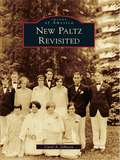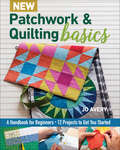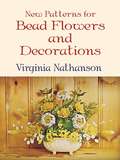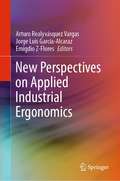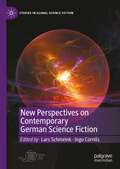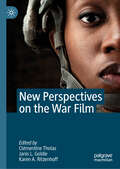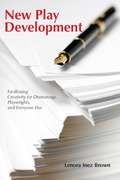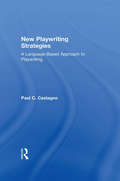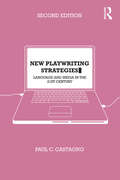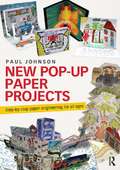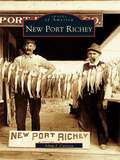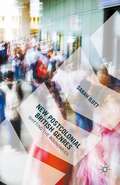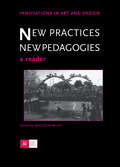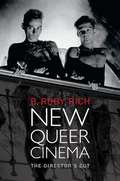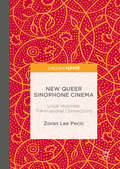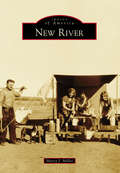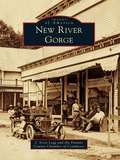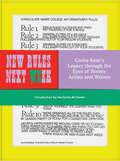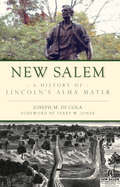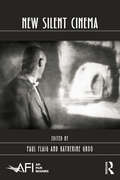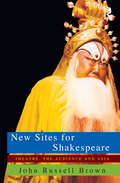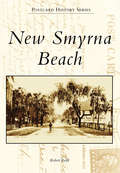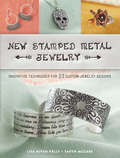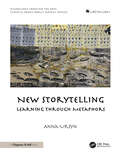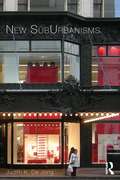- Table View
- List View
New Paltz Revisited
by Carol A. JohnsonNew Paltz was established in 1678 by a small group of Huguenot refugees and their families. These pioneers settled into the fertile Wallkill River Valley with the majestic Hudson River to the east and the Shawangunk Mountains defining the western border. These families endured what today would be insurmountable odds, yet for generations they survived and constantly improved their quality of life. The homesteads of these patentee families still stand along historic Huguenot Street and are testaments to those who built them so long ago. Today New Paltz residents and visitors alike enjoy the various outdoor recreational activities, exceptional educational opportunities, and easy accessibility to nearby metropolitan areas. With carefully selected photographs and detailed text, New Paltz Revisited traces the history of New Paltz from the Colonial era to the present.
New Patchwork & Quilting Basics
by Jo AveryBuild your quilting skills with this beginner&’s guide featuring 12 modern projects using basic patchwork, appliqué, curves, and foundation paper piecing. Quilt designer Jo Avery has a wealth of experience teaching beginner and intermediate quilters at her popular workshops and retreats. In New Patchwork & Quilting Basics, she guides you through 12 quilt projects using basic pieced strips, squares, and triangles. Jo&’s easy-to-follow instructions make it easy to learn new skills while making your own stylish quilts and other projects. Before long, you&’ll have the confidence and expertise to tackle virtually any quilt pattern!
New Patterns for Bead Flowers and Decorations
by Virginia NathansonLavishly illustrated book, with easy-to-follow directions, shows how to fashion a host of exquisite, heirloom-quality beaded decorations, including calla lilies, potted plants, Christmas ornaments, pine cones, bridal bouquets, drapery tiebacks, and other attractive domestic accents. Step-by-step fundamentals and easy-to-master techniques. 23 color illustrations, 119 figures, and 102 photographs.
New Perspectives on Applied Industrial Ergonomics
by Jorge Luis García-Alcaraz Arturo Realyvásquez Vargas Emigdio Z-FloresThis book reports the most recent, advanced, successful, and real applications of ergonomics in order to improve the human well-being and performance in a short term, as well as the organizational performance in a long term. The book is organized as follows: Physical Ergonomics. This section reports case studies where physical risk factors are presented in the workplace, such as physical risk factors including uncomfortable body postures, repetitive movements, force application, manual material handling, and physical environmental conditions. In addition, case studies must report applications from physical ergonomics methods, for instance, RULA, REBA, OWAS, NIOSH, JSI, Suzane Rodgers, ERIN, among others. Cognitive Ergonomics. This section reports the implementation of ergonomic tools, techniques, and methods in real case studies. These applications are aimed to know, decrease, and control cognitive and psychological risk factors, such as mental workload, information processing, situation awareness, human error identification, and interface analysis. These applications may include the following methods NASA-TLX, SWAT, CWA, SHERPA, HET, TAFEI, SAGAT, SART, SACRI, QUIS, SUMI, to mention a few of them. Macro-ergonomics. This section is focused on the analysis, design, and evaluation of work systems. It reports case studies where risk factors are beyond a specific workstation. These risk factors may include supervision styles, teamwork management, task variety, social relationships, organizational culture, organizational communication, technology, work schedules, and motivation, among others. In addition, case studies report the application of macro-ergonomic methods, such as MOQS, focus group, participatory ergonomics, HITOP, MAS, and MEAD, among others.
New Perspectives on Contemporary German Science Fiction (Studies in Global Science Fiction)
by Lars Schmeink Ingo CornilsNew Perspectives on Contemporary German Science Fiction demonstrates the variety and scope of German science fiction (SF) production in literature, television, and cinema. The volume argues that speculative fictions and explorations of the fantastic provide a critical lens for studying the possibilities and limitations of paradigm shifts in society. Lars Schmeink and Ingo Cornils bring together essays that study the renaissance of German SF in the twenty-first century. The volume makes clear that German SF is both global and local—the genre is in balance between internationally dominant forms and adapting them to Germany’s reality as it relates to migration, the environment, and human rights. The essays explore a range of media (literature, cinema, television) and relevant political, philosophical, and cultural discourses.
New Perspectives on the War Film
by Karen A. Ritzenhoff Clémentine Tholas Janis L. GoldieNew Perspectives on the War Film addresses the gap in the representation of many forgotten faces of war in mainstream movies and global mass media. The authors concentrate on the untold narratives of those who fought in combat and were affected by its brutal consequences. Chapters discuss the historically under-represented stories of individuals including women, African-American and Indigenous Soldiers. Issues of homosexuality and gender relations in the military, colonial subjects and child soldiers, as well as the changing nature of war via terrorism and bioterrorism are closely analyzed. The contributors demonstrate how these viewpoints have been consistently ignored in mainstream, blockbuster war sagas and strive to re-integrate these lost perspectives into current and future narratives.
New Play Development: Facilitating Creativity for Dramaturgs, Playwrights, and Everyone Else
by Lenora Inez Brown"This is a book for dramaturgs of new work, but it is also a particularly effective book for anyone working on new plays: playwrights, directors, producers, even actors. Lenora skillfully dissects the process of workshopping new writing, and clearly defines the roles for all involved. I learned not only how to make a new play workshop more effective, but how to approach my writing and my directing, and how to meaningfully collaborate with others in this unique process. This is a necessary handbook for anyone working on new plays today." --Anne Marie Cammarato, Director
New Playwriting Strategies: A Language-Based Approach to Playwriting
by Paul C. CastagnoNew Playwriting Strategies offers a fresh and dynamic approach to playwriting that will be welcomed by teachers and aspiring playwrights alike.
New Playwriting Strategies: Language and Media in the 21st Century (A\theatre Arts Book Ser.)
by Paul C. CastagnoNew Playwriting Strategies has become a canonical text in the study and teaching of playwriting, offering a fresh and dynamic insight into the subject. This thoroughly revised and expanded second edition explores and highlights the wide spread of new techniques that form contemporary theatre writing, as well as their influence on other dramatic forms. Paul Castagno builds on the innovative plays of Len Jenkin, Mac Wellman, and the theories of Mikhail Bakhtin to investigate groundbreaking new techniques from a broad range of contemporary dramatists, including Sarah Ruhl, Suzan Lori-Parks and Young Jean Lee. New features in this edition include an in-depth study of the adaptation of classical texts in contemporary playwright and the utilizing new technologies, such as YouTube, Wikipedia and blogs to create alternative dramatic forms. The author’s step-by-step approach offers the reader new models for: narrative dialogue character monologue hybrid plays This is a working text for playwrights, presenting a range of illuminating new exercises suitable for everyone from the workshop student to the established writer. New Playwriting Strategies is an essential resource for anyone studying and writing drama today.
New Pop-Up Paper Projects: Step-by-step paper engineering for all ages
by Paul JohnsonNew Pop-Up Paper Projects is an inspirational book for everyone who wants to learn and share the magic of pop-up paper engineering. Illustrated throughout with colour diagrams and photographs, this book guides you through basic techniques and foundation skills, offers advice on classroom planning and health and safety and shows you how to ensure that learners of all ages can develop and progress their skills. Guiding you through 90-, 180- and 360-degree engineering, this book presents step-by-step instructions and ideas for over 200 cross-curricular themes, from cityscapes to magical creatures. Aiming to challenge and inspire, Paul Johnson uses over 150 paper-engineering techniques, including: storybooks pop-ups without folds zigzag pop-ups pulleys, wheels and levers asymmetrical pop-ups intricate toy theatres diagonal pop-ups with movables. This book, brimming with pop-up techniques and how to teach them, is for everyone – from the self-styled ‘visually illiterate’ to the art graduate, from parents keeping creativity alive at home to classroom teachers planning an engaging curriculum for their class of 30 plus pupils.
New Port Richey
by Adam J. CarozzaNew Port Richey, Florida, like many cities between Jacksonville and Tampa, can thank Henry Plant's 1885 railroad for its phenomenal growth. Thirty-five miles northwest of Tampa, in West Pasco County, New Port Richey eventually hosted its own railway connection right through downtown. City planners constructed the community in a grid, naming north-south streets after Presidents and east-west streets after states. The arrival of the U.S. Post Office in 1915 confirmed this city's importance and put New Port Richey on the map. Hotels, banks, and businesses sprang up in the downtown area to serve those who came in search of a better life. Fishing on the Pithlachascotee River and in the Gulf of Mexico attracted many visitors, as did the construction of golf courses. Businessmen then and now recognized that this area had "that special something" to catch the attention and the hearts of people from all states north of Florida.
New Postcolonial British Genres: Shifting the Boundaries
by Sarah IlottThis study analyses four new genres of literature and film that have evolved to accommodate and negotiate the changing face of postcolonial Britain since 1990: British Muslim Bildungsromane, gothic tales of postcolonial England, the subcultural urban novel and multicultural British comedy.
New Practices - New Pedagogies: A Reader (Innovations in Art and Design)
by Malcolm MilesWith radical changes happening in arts over the past two decades, this book brings us up to date with the social and economic contexts in which the arts are produced. Influential and knowledgable leaders in the field debate how arts education - particularly in visual art - has changed to meet new needs or shape new futures for its production and reception. Opening up areas of thought previously unexplored in arts and education, this book introduces students of visual culture, peformance studies and art and design to broad contextual frameworks, new directions in practice, and finally gives detailed cases from, and insights into, a changing pedagogy.
New Queer Cinema: The Director's Cut
by B. Ruby RichB. Ruby Rich designated a brand new genre, the New Queer Cinema (NQC), in her groundbreaking article in the Village Voice in 1992. This movement in film and video was intensely political and aesthetically innovative, made possible by the debut of the camcorder, and driven initially by outrage over the unchecked spread of AIDS. The genre has grown to include an entire generation of queer artists, filmmakers, and activists. As a critic, curator, journalist, and scholar, Rich has been inextricably linked to the New Queer Cinema from its inception. This volume presents her new thoughts on the topic, as well as bringing together the best of her writing on the NQC. She follows this cinematic movement from its origins in the mid-1980s all the way to the present in essays and articles directed at a range of audiences, from readers of academic journals to popular glossies and weekly newspapers. She presents her insights into such NQC pioneers as Derek Jarman and Isaac Julien and investigates such celebrated films as Go Fish, Brokeback Mountain, Itty Bitty Titty Committee, and Milk. In addition to exploring less-known films and international cinemas (including Latin American and French films and videos), she documents the more recent incarnations of the NQC on screen, on the web, and in art galleries.
New Queer Sinophone Cinema
by Zoran Lee PecicThis book looks closely at some of the most significant films within the field of queer Sinophone cinema. Examining queerness in films produced in the PRC, Taiwan and Hong Kong, the book merges the Sinophone with the queer, theorising both concepts as local and global, homebound as well as diasporic. Queerness in this book not only problematises the positioning of non-normative desires within the Sinophone; it also challenges Eurocentric critical perspectives on filmic representation that are tied to the idea of the binary between East/West. New Queer Sinophone Cinema will appeal to scholars in Chinese and film studies, as well as to anyone who is interested in queer Chinese cinema.
New River (Images of America)
by Marcy J. MillerLong before the cavalry and stagecoaches traveled through on military roads and the Old Black Canyon Stage Road, the ancient Hohokam people relied on New River's peaks for fortresses and lookouts. In the late 1800s, the military sweep of the last native people, the Apache and Yavapai, rendered the region safe for settlers. Situated between the cool north and the hot, arid Salt River Valley below, New River became a key location for watering sheep and cattle driven between seasonal pastures. Ranches, such as the Triangle-Bar, sprang to life in the cactus-studded foothills. From the 1920s to the 1940s, the arrival of tough, capable homesteaders formed the community that thrives today. Still an unincorporated area of north Maricopa County, New River retains its western heritage and scenic desert vistas
New River Gorge
by J. Scott Legg Fayette County Chamber of CommerceToday visitors to the New River Gorge see a steep gorge filled with a lush hardwood forest. Before the railroad, the New River, with its whitewater rapids, was a barrier to trade, but with the 1873 completion of the Chesapeake and Ohio Railroad, the gorge came alive. By the 1890s, more than 30,000 people lived and worked in the gorge. Towns like Kaymoor, Nuttallburg, and Thurmond were hives of activity and melting pots of American immigrants who dug the coal that helped build the American dream. Times changed. By 1960, the easiest coal was gone, and miners moved to Midwest factories. Nature began to reclaim the gorge. The 1970s brought a rebirth. Whitewater rafters took on the rapids, and bridge builders built the New River Gorge Bridge. The forest has returned, and if you look under the canopy, you will see that the railroads, coal camps, and mine tipples have given way to rafters, rock climbers, and mountain bikers.
New Rules Next Week: Corita Kent's Legacy through the Eyes of Twenty Artists and Writers
by Corita Art CenterTwenty contemporary artists and writers reimagine Corita Kent's iconic creative manifesto.Known for her vibrant and powerful serigraphs, Corita Kent left an equally important legacy through her teaching. In the late 1960s, she and her students at the Immaculate Heart College developed their Art Department Rules. From "Consider everything an experiment" to "Be happy whenever you can manage it," these ten deceptively simple principles capture the magic of Corita's approach to creativity, culture, and activism. In this volume, ten writers and ten artists look back at the rules and show us how vital and resonant they remain today. The wide-ranging roster of contributors includes Vashti Harrison, Lisa Congdon, Natacha Ramsay-Levi, Dan Paley, and Erin Jang.COMPELLING AND INSPIRING ARTIST: Corita Kent was a Roman Catholic nun, a wildly popular pop artist, a social justice advocate, and a beloved art teacher. Her Art Department Rules continue to speak to people today. This book celebrates the way Corita's work resonates through contemporary art and offers inspiration for your own creative practice.TWENTY AMAZING CONTRIBUTORS: Illustrators, designers, educators, curators, former students and colleagues of Corita's—the illustrious contributors to this volume offer a kaleidoscope of perspectives on the artist's legacy. PERFECT GIFT: This book makes an impactful gift for creative minds, especially students. The ten rules offer encouragement and guidance to anyone who aspires to begin or expand an artistic practice.Perfect for:Fans of Corita Kent's artwork, teaching, and activismArt school students, creative professionals, and artists of all kindsDevotees of the "Pop Art Nun," Andy Warhol, Ben Shahn, and activist artFans of art- and activism-focused coffee table books, art retrospectives, and creativity workbooks like The Artist's Way
New Salem: A History of Lincoln's Alma Mater (Brief History)
by Foreword By Jones Joseph M. ColaIn 1829, eleven years after Illinois became the twenty-first state, New Salem was founded on a bluff above the Sangamon River. The village provided an essential sanctuary for a friendless, penniless boy named Abraham Lincoln, whose six years there shaped his education and nurtured his ambition. Eclipsed by the neighboring settlement of Petersburg, New Salem had dwindled into a ghost town by 1840. However, it reemerged in the early part of the twentieth century as one of the most successful preservation efforts in American history. Author Joseph Di Cola relates the full story of New Salem’s fascinating heritage.
New Silent Cinema: Digital Anachronisms, Celluloid Spectacles (AFI Film Readers)
by Katherine Groo Paul FlaigWith the success of Martin Scorsese’s Hugo (2011) and Michel Hazanavicius’s The Artist (2011) nothing seems more contemporary in recent film than the styles, forms, and histories of early and silent cinemas. This collection considers the latest return to silent film alongside the larger historical field of visual repetitions and affective currents that wind their way through 20th and 21st century visual cultures. Contributors bring together several fields of research, including early and silent cinema studies, experimental and new media, historiography and archive theory, and studies of media ontology and epistemology. Chapters link the methods, concerns, and concepts of early and silent film studies as they have flourished over the last quarter century to the most recent developments in digital culture—from YouTube to 3D—recasting this contemporary phenomenon in popular culture and new media against key debates and concepts in silent film scholarship. An interview with acclaimed Canadian filmmaker Guy Maddin closes out the collection.
New Sites For Shakespeare: Theatre, the Audience, and Asia
by John Russell BrownIn the course of exploring the theatrical cultures of South and East Asia, eminent Shakespeareanist John Russell Brown developed some remarkable theories about the nature of performance, the state of Western 'Theatre' today, and the future potential of Shakespeare's plays. In New Sites for Shakespeare he outlines his passionate belief in the power of theatre to reach mass audiences, based on his experiences of popular Asian performances. It is a personal polemic, but it is also a carefully argued and brilliantly persuasive study of the kind of theatrical experience Shakespeare's own contemporaries enjoyed. This is a book which cannot be ignored by anyone who cares about the live performing arts today. Separate chapters consider staging, acting, improvisation, ceremonies and ritual, and an analysis of the experience of the audience is paramount throughout.
New Smyrna Beach (Postcard History Series)
by Robert ReddIn 1768, Scottish physician Andrew Turnbull arrived in Florida with more than 1,200 indentured servants. He and his partners dreamed of establishing a plantation settlement that would make them wealthy. Despite some successes, New Smyrna was not the financial windfall they had hoped for, and after only nine years, the settlement failed. Disgruntled workers appealed to East Florida governor Patrick Tonyn, who granted them their freedom. Many of the now free settlers took residence in St. Augustine. In the succeeding years, New Smyrna has seen Civil War skirmishes, the addition of �Beach� to its name, a merger with Coronado Beach, the rise and fall of the rail industry, and a marked increase in local and out-of-state tourism. The �World�s Safest Bathing Beach� is no longer a local secret.
New Stamped Metal Jewelry: Innovative Techniques for 23 Custom Jewelry Designs
by Lisa Niven Kelly Taryn MccabeInnovative Techniques for 23 Custom Jewelry Designs
New Storytelling: Learning through Metaphors
by Anna UrsynThere is a global need to become less fearful of coding, as it improves communication with the coders on the job and helps with prompt writing, which hiring companies often request. This set of story-based learning projects links performances and tasks with computing codes to show how a machine translates our goals into its language. Metaphors link instructions telling a computer what task to perform with similar functions in other disciplines. The materials serve those in Computer Graphics, Digital Media, or anyone interested in understanding and becoming familiar with principles and the logic behind coding, and help understand machines when writing a prompt. Dance, music, and performing visually present knowledge through stories and serve as a metaphor for understanding how coding and current technologies affect various disciplines. By introducing basic ideas behind programming in a symbolic way, this book shows how computing and nature overlap through storytelling.Most jobs are collaborative, and coding involves many parts of production processes. These knowledge-based stories improve communication between the artists and the coders to bridge the gap between them.It is a part of the “Knowledge Through the Arts” series, consisting of:Dance Code - Dance Steps as a CodeNew Storytelling - Learning Through MetaphorsCode Appreciation - Reshaping KnowledgeNature Appreciation - Knowledge as Art
New SubUrbanisms
by Judith K De JongHistorically, we see the city as the cramped, crumbling core of development and culture, and the suburb as the vast outlying wasteland – convenient, but vacant. Contemporary urban design proves this wrong. In New SubUrbanisms, Judith De Jong explains the on-going "flattening" of the American Metropolis, as suburbs are becoming more like their central cities – and cities more like their suburbs through significant changes in spatial and formal practice as well as demographic and cultural changes. These revisionist practices are exemplified in the emergence of hybrid sub/urban conditions such as parking practices, the residential densification of suburbia, hyper-programmed public spaces and inner city big-box retail, among others. Each of these hybridized conditions reflects to varying degrees the reciprocating influences of the urban and the suburban. Each also offers opportunities for innovation in new formal and spatial practices that re-configure conventional understandings of urban and suburban, and in new ways of forming the evolving American metropolis. Based on this new understanding, De Jong argues for the development of new ways of building the city. Aimed at students and practitioners of urban design and planning New SubUrbanisms attempts to re-frame the contemporary metropolis in a way that will generate more instrumental engagement – and ultimately, better design.
